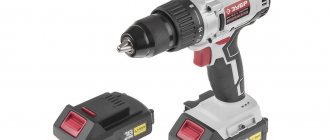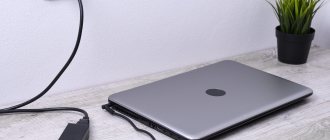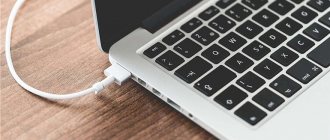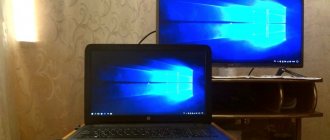A compact mobile device, a laptop, is not inferior to a computer in the complexity of the tasks it solves. But its Achilles heel is considered to be the battery. The device requires certain maintenance conditions and can discharge at the most inopportune moment. Sometimes a working battery does not charge on a laptop, why does this happen? This and other issues regarding combining the functions of a battery and a laptop are discussed in the article.
BIOS problem
Read also: [Instructions] How to connect a printer to a computer on Windows 10 and Mac OS
If none of the above worked, then the problem with the laptop's power management and charging may be due to an early version of the BIOS.
In this case, resetting the BIOS settings will help the computer owner. To do this, we perform the following actions:
- Turn off the device
- We take out the battery
- Disconnect the charger from the network
- Press the start key and hold it for a minute
- Connect the laptop to a power outlet without a battery
- Turn it on and go into BIOS
Logging into BIOS for various laptop models
- Acer - keys such as F1, F2 or Del.
- Asus - F2 or Del keys.
- Lenovo - the same keys as in previous cases or F12
- HP - you can press the same buttons or Esc.
Other netbook/laptop models use the same keys as described above during boot.
You must read the start menu carefully; usually there are hints at the bottom of the screen .
1Find the Load Defaults (it is located in the EXIT menu). This way you will set the default settings that are optimal for your laptop.
2After the BIOS prompts you to save the settings, click YES and then turn off the device by pressing the start button and holding it for 10 seconds.
3Disconnect charging, insert the battery and you can start the computer.
After completing these steps, the system reports correct charging and battery detection.
Use the next step if none of the above helped.
Find downloads on the official website of the manufacturer of your computer brand, in the “Support” download and install the updated BIOS version.
Don't go wrong with your device model!
It is very important to carefully read the official instructions from your manufacturer for updating! They are in the download file.
Reset battery settings in bios
The BIOS has a memory block containing hardware configuration data.
To reset the battery settings on this system you need to:
- Disconnect the device from the network (remove the plug from the laptop socket).
- Remove the battery. For most models, it is removed by pressing the locking device.
- Press the device power button and hold for 20-45 seconds.
- Insert the power supply plug into the laptop socket, connecting it to the mains.
- Turn on the device and enter the BIOS task manager (Del + F12 or Del + F2).
- Restore Defauts.
- Save changes and exit BIOS manager.
- Turn off the laptop.
- Disconnect the power supply.
- Reinstall the battery.
- Insert the charging plug into the socket.
- Turn on the device as usual.
You can check if this helped by hovering your mouse over the battery icon in the tray. “connected, charging” should appear .
Should I repair the battery or buy a new one?
New battery
If you know specialist people who can do this, then contact them.
But you need to understand that this process is very labor-intensive and requires considerable skill and practice.
Unfortunately, many companies assure you that they will help you, but in fact they only want your money, and after the intervention of “such specialists” you will have to buy a new battery.
By the way, the cost of such services is often the same as a new battery.
Today, the electronics market is overflowing with offers.
And without much difficulty you will get a high-quality Chinese-made battery, which is not inferior in quality to the original, but at the same time costs an order of magnitude cheaper.
But I strongly recommend that you read reviews on forums and in the comments of online stores before purchasing a charger. Don't buy a pig in a poke!
In any case, do not be discouraged, follow the points given in this article.
If you are unable to resolve this problem on your own, then contact a good service center.
Remember that the device’s battery must be treated with care, as it is a consumable item that can very easily fail.
VIDEO: What to do if the battery on your Laptop does not charge - Video instructions
What to do if your laptop battery does not charge
A laptop without a full battery becomes an ordinary desktop device, somewhat weaker than a home computer. It is connected to the network, there is a danger of losing some of the material if there is a sudden power outage. Therefore, if your laptop battery does not fully charge, you need to urgently find and fix the problem.
Is it known for certain that your battery has lost more than half its capacity? Tested using the above programs. It is necessary to determine the degree of damage to the battery and whether it can be animated.
Experts do not recommend installing a refurbished lithium battery in the case. Resuscitation associated with replacing part of the cells will extend the battery life for a short time, but will increase the risk of fire and explosion of the laptop.
If there is an analogue to the original battery, you need to buy it with an eye on the manufacturer. Too often, batteries that do not correspond to the declared capacity and with unsatisfactory assembly end up in the trade. It is important to buy a fresh device with a minimum level of self-discharge.
When purchasing a new battery, it is best to test its compatibility with your laptop on site. It is important that the connectors and voltage match. The capacity can be slightly larger, the voltage can be changed to 0.3 - 0.5 V. The newly installed battery needs to be pumped - fully charging and discharging several times. For this period, in the settings you need to remove the restriction on the glowing screen and the discharge level. Simple actions will lead to full use of battery resources.
Checking programs
When diagnostics show little wear, the problem may lie in the running programs. Perhaps one of the previously installed applications running in the background is interfering. Because of it, the system goes into energy saving mode.
To check, you need to open the Manager (Ctrl+Shift+Esc) and find programs that use the processor. If you get rid of unnecessary applications, your computer's battery life will increase.
Repair versus purchase
When faced with worn out or malfunctioning laptop batteries, users have 2 options for solving the problem. This means repairing an old battery, or purchasing a new device.
It is important to understand that much depends on the severity of the malfunction. If this is a software problem, you can solve it yourself. Physical damage can potentially be eliminated. Especially if you believe the masters who only pursue the goal of obtaining financial gain.
Objectively, repairing old laptop batteries is a complex and time-consuming process. And that's why it's expensive. Often the price is comparable to buying a new battery, and not of the worst quality.
If you choose between repair and purchase, then preference should be given to the second option.
Have you encountered similar problems? What was the reason and how did you manage to solve it? Share your stories and personal experiences.
Subscribe, comment, leave reviews and ask questions!
The power supply is working, but there is no charge
Charging problems also occur in new devices. Therefore, it is customary in stores to check the laptop’s functionality before purchasing.
If the new device does not work as expected, follow these steps:
- Initialize the battery. It sounds serious, but the procedure is extremely simple.
- Turn off the laptop and unplug the cord.
- Remove the battery.
- Press and hold the “Power” button for 20 seconds.
- Place the battery back and connect the cord.
Such manipulations restore the power supply.
The culprit is the battery.
Modern mobile computers are equipped with lithium-ion or lithium-polymer batteries because they are capacious (have a high charge density), charge quickly, are capable of delivering high currents to consumer devices without harm, have a low level of self-discharge, and are inexpensive. However, the actual service life of lithium batteries is not very long - with normal use it rarely exceeds 3-4 years. And signs of wear appear even earlier - already 1.5-2 years after purchase.
How to tell if your battery is worn out and needs to be replaced
Natural aging of the battery makes itself felt by the following signs:
- The computer's battery life is noticeably reduced.
- The charge level indicator gives incorrect values. For example, the laptop was just charged to 100%, but after a few minutes it was discharged to 0. Or the charge seems to be high, but the system asks to connect the power source, and if it is not connected, the computer turns off.
- System monitoring utilities, like Aida64 and HWiNFO (in the screenshot below), show a high percentage of battery wear (Battery Wear level parameter).
The Wear level of a new battery is a few percent (it loses a little capacity during storage). When reaching 40-50%, the symptoms of aging appear “in all their glory.” When worn out by 75-90%, a mobile computer, as a rule, turns into a desktop and is powered only from an outlet.
Attempting to charge a badly worn battery, especially one with signs of swelling and leaks of electrolyte on the case, is not only useless, but also dangerous - it can lead to a fire and explosion of the lithium!
Does it make sense to repair an exhausted laptop battery? Most often, no, since this is associated with significant technical difficulties and simply replacing cans (batteries) is not enough. And such repairs usually cost more than buying a new battery.
What if this is a malfunction?
Battery failure manifests itself with the same symptoms as significant wear and tear, but they do not develop as they age, but simultaneously. In addition, a laptop may stop working altogether with a faulty battery: when it is installed, it does not turn on. However, most often the device simply stops seeing the faulty battery or refuses to charge it.
A battery failure is not always easy to distinguish from a failure of the charging system on the board. Connecting a similar, known-good battery helps differentiate these faults at home. If the computer works fine with it, then the charging circuit is in order, and it’s time for the broken battery to go in the trash.
Charging and using faulty laptop batteries is just as dangerous as severely worn ones.
How to choose a battery to replace a failed one? It’s very simple: just know its Product ID - a unique identifier consisting of numbers and letters that manufacturers assign to a specific model.
Product ID is indicated on the inner surface of the battery case.
Batteries for laptops of the same model range are usually interchangeable.
Overdischarge is serious
Lithium power supplies are designed in such a way that when the energy drops below a minimum threshold (3.3–2.7 V), they are blocked by an internal protection system. An overdischarged battery cannot be charged. Unfortunately, this condition is not always reversible. In some cases, the battery is “revived” by a long, many-hour connection to a current source or by replacing the elements of the protection circuit by the hands of repairmen. However, after such “reanimation” its capacity does not always return to its previous level; most often it remains reduced.
When overdischarged, the computer sometimes sees the battery and determines its level, but cannot charge it. Neither during operation nor after shutdown.
Fortunately, critical overdischarges of laptop batteries rarely occur, since this is carefully monitored by the operating system.
Fatal incompatibility
The battery supplied with the laptop is unconditionally compatible with the motherboard and the original power adapter. The same cannot be said about those bought to replace it, especially those with a pedigree from basement factories in the Middle Kingdom. The reason is low quality, or even a fake.
In addition, incompatibility occurs in cases where a completely usable battery was released much later or earlier than the laptop. The problem is that the motherboard does not recognize the version of the internal battery controller. It happens that the issue can be resolved by updating the computer's BIOS, but more often, unfortunately, not.
When the actual battery capacity is lower than the rated capacity
Battery capacity decreases over time - this is a natural phenomenon. However, in nature there are batteries with an initially low, but artificially high capacity, which is “depicted” by unscrupulous manufacturers and sellers. They either put false information about the capacity on the battery case or sew it into its controller. The second method is sometimes to “rejuvenate” very old batteries that have almost exhausted their service life in order to sell them to an inexperienced buyer.
The first version of the deception can be easily uncovered using utilities for collecting information about the system, for example, Aida64 (in the screenshot below). The second - only indirectly - by calculating the time of complete discharge from 100% to conditional zero.
An overestimated battery capacity makes itself felt by the laptop's too short battery life and often incorrect charge indication.
It's all about calibration
A laptop battery is a rather complex device that is controlled by its own internal controller. It not only protects batteries from overcharging and overdischarging, but also monitors the charge level. Along with it, the charge level is controlled by a circuit on the motherboard. Normally, the data from both controllers coincide, but after repeated charging and discharging cycles, discrepancies appear in the indicators. Because of this, the system begins to “think” that the battery capacity has decreased and does not allow it to be fully charged.
To eliminate this error, perform a battery calibration operation: charge it to 100%, and then allow it to discharge to a minimum, waiting for the laptop to turn off spontaneously. After switching on again, the capacity value is already displayed correctly.
Mobile computer manufacturers recommend performing a calibration procedure every few months.
Information for reference
In the end, it should be noted that there are a couple of nuances in the operation of the systems:
- Windows 10 notifies that charging is not happening when the power supply is disconnected and later connected back. For example, the computer worked autonomously for 5 minutes, the charge level dropped by several percent, after which it was connected to the network.
- Some computers have a feature that limits the charge level in the BIOS. The option can be disabled independently or using a wizard.
- If the Android is charging from the laptop via a USB cable, the charge level may remain at the same value or decrease. If the laptop works without a network connection, it is better to turn off the phone.
Almost all solutions to battery charging problems are the same, but they may differ for different laptop models. For example, for HP, turning the system on and off often helps, for Dell computers - updating the BIOS, and for Asus or Sony - installing new drivers.
Malfunctioning laptop battery is a common problem from which no gadget is immune. Before taking the equipment to the service center, you should try to restore the system yourself. In more than 80% of situations, the above algorithms solve the battery problem. When the above manipulations do not help, give an answer to the question “Why is the battery not charging on a Samsung, Lenovo, Toshiba or Samsung laptop?” can at the service center.
Fighting overheating
Batteries may become hot. If your laptop overheats, it can cause problems. As temperatures rise, the battery sensor may fail. In this case, it will show that the battery is fully charged or completely discharged, and then problems with recharging will arise. The system may be turned off to prevent overheating and fire.
Such problems most often arise with older laptops, where the cooling system is of lower quality compared to modern models. Or if you use your laptop on the sofa or in bed, which may block the cooling vents. Turn off the device, give it time to cool, and make sure that the openings are not clogged with dirt or blocked by a blanket or anything else.
Main reasons
Situations are different. Some users notice that the power supply connection indicator lights up, but the charging process itself does not occur. Or the computer does not react at all to being connected to an outlet.
The reason is not always fatal, that is, it exclusively means the need to change the battery. Sometimes it happens that you need to slightly adjust the settings, and everything will start functioning normally.
Mostly laptop batteries stop charging due to:
- tension;
- cord;
- overheating;
- BIOS;
- drivers;
- OS updates;
- power supply;
- programs;
- wear.
The most surprising situation is when everything is fine with the power supply, but there is still no charge.
Each potential cause requires separate consideration.
Voltage
One of the reasons why the battery on a laptop does not charge is low voltage.
Quite a common occurrence. At the same time, a notification appears in the notification area on the laptop display indicating that the battery has begun the charging process. But in parentheses it is additionally indicated that the device is connected, but is not charging.
Everything is quite simple here. The most important thing is that the fault is unlikely to be on the part of the laptop itself, the battery or the charger. It's just a matter of the network through which charging is carried out, low voltage.
Those who have an RCD at home or in an apartment can simply open the panel and see what the current voltage is in the network. The problem may be throughout the entire house. Or a specific outlet has failed.
If the overall voltage is normal, switch to a different outlet. Provided that after this the charging process begins to proceed normally, you will have to deal with the problem socket.
Cord
It happens that the laptop battery is connected, but it does not charge. And this cannot but worry the user.
In such a situation, the fault is most likely on the charger cord side. This usually manifests itself in the form that the charger is connected, but at the same time the adapter does not charge the battery, and the laptop cannot function normally.
There is a high probability that some wire under the braid is damaged, broken or frayed.
If the laptop does not charge, you should check the voltage of the charger. Here you can arm yourself with a regular universal multimeter. If there is no voltage, try connecting another charger to the laptop and see if the situation changes after that.
But most often, users do not have a spare power supply. Therefore, the only option here is to buy a new charger.
It's important to make sure that the charger is actually not working, and not just on your laptop. Otherwise, you will waste your money on purchasing an accessory.
Overheat
One of the reasons why the laptop does not charge from the charger may be overheating of the battery.
Intensive use and increased load on the device can lead to the laptop starting to heat up actively. To protect the battery from damage, the system locks and prevents the battery from charging.
Dust accumulation is the most common cause of laptop overheating
There is also a slightly different situation. It consists of plugging the laptop into a power outlet, charging for a few minutes, and then the process just as quickly stops. Surely the battery is overheating and the protection is triggered. It does not allow voltage to continue to be supplied to the battery.
And here the reason is in the battery or in the unit. The unit may break and supply too much voltage to the battery. It cannot withstand such a load and turns off. Or the battery itself has internal faults, which lead to an intense increase in its temperature.
Lack of charge with a working unit
Many users are quite naturally interested in the question of why the battery on their laptop is not charging, although the power supply itself is fully functional and there are no complaints about it.
This is especially strange to observe when a completely new laptop computer is purchased, connected to charging, but the process of restoring the battery capacity does not occur. And the machine itself works with a licensed version of the operating system. In theory, everything should work, but nothing does.
A possible but unlikely factor could be a manufacturing defect. Objectively, such problems are extremely rare.
A much more likely cause is improper battery initialization. This is a consequence of problems on the part of the controller.
It is recommended to do the following:
- turn off the laptop;
- disconnect the cable from it;
- remove the removable battery;
- hold down the power key for about 15-20 seconds;
- return the battery to its place;
- connect the battery;
- turn on the laptop.
It is important to consider that such measures do not help in all cases. But they are as safe as possible and simple to implement. There is a chance that after this everything will start functioning normally.
Experts emphasize that the presented method has 2 more alternative options.
- Suitable only for laptops that use a removable battery. It is necessary to disconnect the charger, remove the battery, press the power button and hold it for 1 minute. Then connect the battery, and then the charger. The laptop remains turned off for 15 minutes and only then turns on.
- The second option is relevant for laptop computers with an integrated battery, which cannot be simply removed. In this situation, you don’t even need to remove the battery. When the laptop is turned on, charging is turned off. Then the power button is pressed until the device turns off within a minute. Then you need to connect the charger, wait 15 minutes, and start the computer.
Here it is important to strictly follow the sequence of actions, and in no case violate it. Otherwise, nothing simply will work.
BIOS
Another scenario, when the laptop battery for some reason does not charge, involves possible problems with the BIOS.
If none of the previously presented measures helped, you should pay attention to the laptop's power supply and charger management related to the BIOS.
In this situation, a factory reset could be a potentially effective solution. To do this you need:
- turn off the laptop and wait until the display goes out completely;
- then disconnect the charger from the network;
- then remove the battery;
- Now you should hold down the computer power button and do not release it for 1 minute;
- then the laptop is connected to the outlet directly, that is, without installing the battery in its place;
- The computer turns on and you enter the BIOS;
- when the device boots, a notification usually appears at the bottom of the screen indicating which buttons or combinations can be pressed to enter the BIOS;
- Once in the required BIOS system, use the arrows on the keyboard to move to the “Exit” section;
- here find the item called “Load Defaults”;
- then the BIOS will offer to save the new settings, and you need to confirm this action;
- then turn off the computer by pressing the start button and holding it for about 10 seconds;
- Unplug the charger, reinsert the battery, and turn on the computer as usual.
If the reason was due to broken or incorrect BIOS settings, then after these manipulations the system will normally recognize charging, and confirmation of the detection of the charger with a growing charge indicator will appear on the screen.
IMPORTANT. As a last resort, when the above measures did not help, find and download the latest BIOS version on the laptop manufacturer’s website.
It is installed on the computer, after which it reboots. This usually allows the device to resume normal operation.
The main thing is to choose the right laptop model so as not to accidentally install a BIOS designed for another laptop. Otherwise, quite serious problems may arise.
Drivers
Some users are faced with the fact that the battery on an Asus laptop does not charge for unknown reasons. The same can happen on devices manufactured by HP, Dell, Lenovo, etc.
The bottom line everywhere is that the battery on their laptop is not charging, and therefore they need to take some action.
Remember the circumstances after which you discovered that the battery on an Acer or other manufacturer’s laptop is not charging. Perhaps everything was fine yesterday, but today the situation has taken on an unpleasant form.
Then it is recommended to do the following:
- open "Device Manager";
- go to the “Batteries” section;
- find the item “Battery with API compatible management”, or something similar.
If there is nothing like this in the dispatcher at all, this is a sign of a malfunction. The computer does not see the charger. One reason is poor contact.
If there is a battery in the manager, right-click on it and then click on “Delete”. Confirm the action and send the device to reboot.
The operating system should automatically detect the new device and install the appropriate driver. It is important that you have an Internet connection.
There is also a slightly different situation in which the battery on the laptop still does not charge. Be it Dell, Sony, Samsung or any other brand of laptop computer.
Its essence is that problems with the battery arise after installing the next operating system updates, or after a complete reinstallation of the OS. There is a high probability of missing chipset driver and power management.
ATTENTION. In this case, the device manager may show that the drivers are installed and there are no updates for them, they are the latest.
In this case, it is recommended to go to the website of your laptop manufacturer, find the necessary drivers there, download and install them.
Do not be alarmed if the battery on your laptop, even a new one, does not charge. This is a fairly common phenomenon for many budget devices from Lenovo, Asus and other companies. But often the problem is solved independently and quickly.
If you find that for some reason your laptop’s battery is not charging, go through all the points listed above and try to determine the reason on your own.
Each situation has its own recommendations on what to do if the battery does not charge and the laptop cannot function autonomously. While the problem is being resolved, there is always the option to connect directly from the network.
It is worth adding that these are not all possible reasons.
power unit
When the above methods do not help, we can almost certainly conclude that the power supply itself is faulty.
First, check whether the block indicator works, if such is provided by its design.
If the unit does not turn on without using the adapter, then the fault may lie with it. Although problems with connectors and electronic components cannot be ruled out. Not only the charger itself fails, but also the controller located inside it.
Also, craftsmen from personal experience note that they often have to deal with damaged contacts, oxidation and rust.
The simplest solution in this situation is to use a different charger. If the laptop works fine with the new unit, it recognizes it and increases the battery charge level, then you need to fix this problem.
Yes, since the laptop is not charging, you can work from the network for a while. But this deprives the device of its main advantage over a PC in the form of mobility.
Programs
It also happens that the battery itself is connected, but it does not charge, and the laptop’s charge is not replenished. This happens on different devices, be it Asus, Acer or Dell.
The peculiarity of the situation is that the computer sees charging, the process seems to be going on, but still the battery does not increase its charge level. Sometimes it even moves downwards.
It is possible that the laptop consumes more energy resources than the charger can provide. This is mainly true for computers with weak batteries, or with batteries that are already quite worn out. Plus, there are powerful programs running in the background that consume a large amount of resources. To check them, you can open the Task Manager and go to the “Processes” tab. See which ones are the most taxing on your CPU.
Try turning off the most energy-consuming programs and watch how the charging process changes after that. Perhaps the battery is simply worn out.
Check for wear
Old batteries may not charge or may not charge completely. This usually occurs after numerous charge and discharge cycles. This leads to a decrease in capacity. That is, even with a full charge indicator, the battery drains quickly.
Here it would be a good idea to find out the current degree of wear and tear of the power supply for your laptop computer. The easiest way to do this is through a service center. But you can do it on your own.
Since the reasons why the laptop does not charge and only works from the mains may lie in the wear of the battery, you should check its condition.
One option involves using the command line. To do this you need:
- open command line;
- enter powercfg energy here;
- press Enter;
- wait for the detailed report to display.
IMPORTANT. In some cases, the system may request extended access rights. Therefore, it is better to run the command line as an administrator.
After processing the request, a file with a detailed report is generated. The path to it is indicated in the command line window. Check the report for the calculated capacity and the last full charge. If the difference between them is large, then this indicates severe wear of the battery.
You can also check the battery status using third-party programs. They also provide a detailed report, which allows you to really evaluate the performance of the battery.











